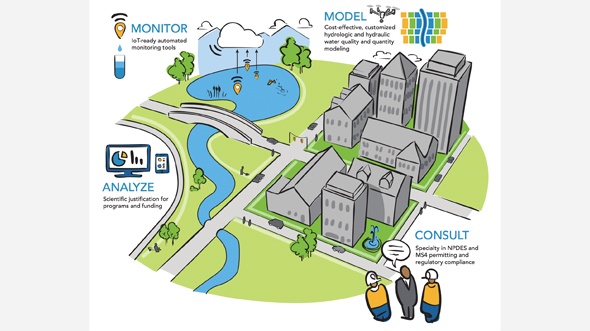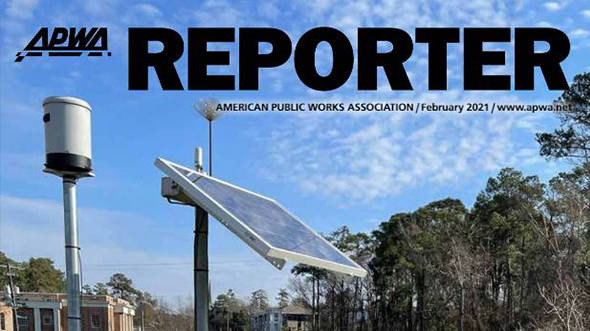
BLOG
—
Regulations Don’t Require Continuous Monitoring for Water Quality, So Why Invest?
Today’s stormwater management technology enables local providers to continuously monitor water quality in streams and rivers. However, at present, federal and state environmental agencies only require periodic water quality samples. So why should communities invest in technologies that will provide continuous data about the quality of the water in their lakes, rivers, streams and other waterways?
First, a little background. Local governments that manage stormwater systems are issued National Pollutant Discharge Elimination System permits by the U.S. Environmental Protection Agency or state agencies that administer these requirements. The permits set the standards and regulations for monitoring and reporting the levels of nutrients in waterways, such as phosphorus and nitrogen. These nutrients are considered pollutants because they can stimulate harmful algal blooms, one of the most pressing water quality issues of our time. NPDES permits often require that municipalities collect periodic water samples and report the nutrient levels, or the levels of other pollutants of concern.
Municipalities do their best to keep their waterways clean and stay in compliance, but limited resources often play a role in how frequently samples are taken. Investing in remote sensing technology reduces the demand on labor and lab testing fees over time, and municipalities that continually monitor water quality know the status of their water quality all day, every day. Why have they chosen to make that investment? Here are five top reasons why:
- Accuracy. One-off samples can be misleading. Water quality conditions can change within minutes, especially during inclement weather, making infrequent samples an unreliable assessment of overall consistent water quality.
- Protection. Improving water quality protects public health, encourages recreation, and preserves the environment and habitats. In some cases, it improves the drinking water of a community.
- Prevention. Consistent monitoring can identify sources of pollution by analyzing patterns of data over time. This can help communities get ahead of any recurring issues by addressing problems at their origin.
- Justification. If a municipality can prove where pollution originates, fines and expensive water treatment solutions can be avoided, justifying upfront investment costs.
- Resilience. As the focus on water quality and water management continues to increase, regulations will get stricter. By implementing improved monitoring technology, municipalities will be well positioned to align with evolving standards.
One Sample Versus Thousands of Samples
One-off samples are to continuous monitoring as photographs are to videos. Samples give you a glimpse of conditions at a moment in time, whereas continuous monitoring can provide robust data that reflects a waterway’s conditions throughout the day, the week or even months. Regulatory agencies use the results from periodic samples to assess local waterbodies and often impose costly restrictions on communities that are managing stormwater runoff. Continuous monitoring benefits these communities because the data can help discern where elevated nutrient levels are coming from, which may not be from the NPDES-permitted stormwater system. Conversely, the data may show the problem is worse than the one-off sample indicated, enabling the community to be proactive and address the issue before a public outcry ensues and additional fines are imposed.
Depending on the municipality, periodic sampling may occur once a month or only once a quarter. An employee of the municipality physically retrieves a sample of water from a river or stream, sends the sample to a lab and awaits the results, which can take over a week. By contrast, remote sensing technology used for continuous monitoring can collect data every 15 minutes and transmit the results in real time, where it can be accessed online.
It’s the difference between knowing the water quality in one moment or nearly 3,000 moments over a 30-day period, providing accurate, constructive and defensible data.
Pattern Analysis, Pollution Sources and Disaster Management
Continuous monitoring data enables crucial patterns to emerge. These data determine when and where a local manufacturer or other industrial business is discharging pollutants into the stormwater system or local waterways. When there is only a handful of periodic samples over the course of a year, it’s extremely difficult to pinpoint the sources of pollution. Prevention, as they say, is worth a pound of cure. And when it comes to pollution, the financial and environmental benefits of prevention can save millions of dollars in cleanup and noncompliance.
In addition to gauging nutrient levels and the presence of algal toxins, continuous monitoring can incorporate rainfall and runoff volume in waterways throughout a community, providing current and actionable information to protect residents and infrastructure during heavy rains and potential flooding events.
Water quality and effective water management will always be essential to any community and will only become more important as cities grow and the climate changes. Fortunately, technology has advanced to address water pollution, flooding and regulatory compliance needs, making it well worth the investment.
Share this Post

James Riddle
Woolpert Vice President and Project Manager James Riddle, PE, has extensive experience in water resources and is an expert in surface water monitoring to assist local governments in flood monitoring and complying with state and federal water quality requirements. He works out of the firm’s Columbia, S.C., office.

Stephanie A. Smith
Xylem-YSI Integrated Systems and Services Product Segment Manager Stephanie A. Smith is an expert in environmental monitoring, specializing in harmful algal blooms and associated water quality issues. Last week, she wrote an outstanding blog on “Three Stormwater Solutions for a Changing Climate.”


